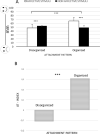Disorganized Attachment pattern affects the perception of Affective Touch
- PMID: 32541672
- PMCID: PMC7295781
- DOI: 10.1038/s41598-020-66606-5
Disorganized Attachment pattern affects the perception of Affective Touch
Abstract
Touch, such as affective caress, can be interpreted as being pleasant. The emotional valence that is assigned to touch is related to certain bottom-up factors, such as the optimal activation of C-tactile (CT) afferents. Tactile processing with a hedonic or emotional component has been defined as affective touch-a component that CT fibers are likely to convey. Tactile deficiencies are frequent in the psychiatric population but also in healthy people with disorganized attachment; accordingly, it is likely that affective difficulties in adults with disorganized attachment are reflected in altered perception of affective touch. To test this hypothesis, we combined methods from clinical psychology, psychophysics, and neuroimaging. We found that people with a history of traumatic parental bonds and a disorganized attachment pattern perceive a "caress-like" stimulus as being unpleasant, whereas participants with organized attachment consider the same tactile stimulation to be pleasant. Further, unlike in organized adults, the responses of disorganized adults to CT and non-CT stimulation activated limbic and paralimbic structures in a fight-or-flight manner, suggesting that early experiences with parental deficiencies shape the physiological responses of peripheral CT fibers and central nervous networks.
Conflict of interest statement
The authors declare no competing interests.
Figures


References
-
- Bremner AJ, Spence C. The development of tactile perception. Adv. Child Dev. Behav. 2017;52:227–268. - PubMed
-
- McGrath, J. M. Neurologic development in Developmental care of newborns and infants (eds. Kenner, C. & McGrath, J. M.) 105–118 (St Louis, MO: Mosby, 2004).
-
- Humphrey T. Some correlations between the appearance of human fetal reflexes and the development of the nervous system. Prog. Brain Res. 1964;4:93–135.
-
- Hooker D. The prenatal origin of behavior. Lawrence, KS: University of Kansas Press; 1952.
MeSH terms
LinkOut - more resources
Full Text Sources
Medical

